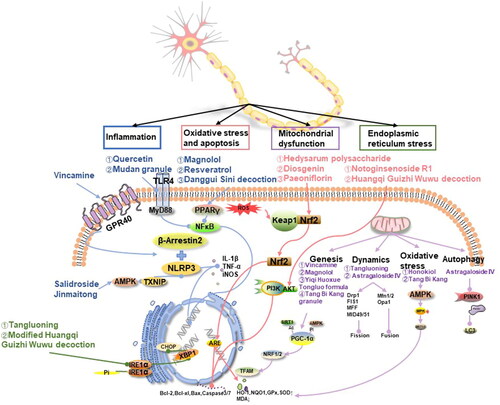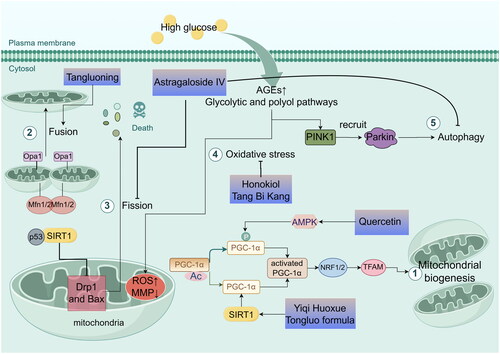Figures & data
Table 1. Single herbal extracts for the treatment of DPN.
Table 2. TCM compound formula for the treatment of DPN(Preclinical).
Table 3. TCM compound formula for the treatment of DPN(clinical).
Figure 1. Mechanisms and representative drugs of TCM in treating DPN. Inflammation (blue): alleviated through AMPK, GPR40, TLR4 and PPARγ signal pathways. Oxidative stress and apoptosis (red): inhibit oxidative stress, and apoptosis through Keap1/Nrf2 and PI3K/AKT pathways. Mitochondrial dysfunction (purple): the regulation of mitochondria can be divided into mitochondrial biogenesis, dynamics, oxidative stress and autophagy. Endoplasmic reticulum stress (green): TCM inhibits endoplasmic reticulum stress through the IRE1α/XBP1/CHOP signaling pathway. AMPK: the adenosine 5′-monophosphate (AMP)-activated protein kinase; GPR40: G protein-coupled receptor 40; TLR4: Toll-like receptor 4; PPAR: the peroxisome proliferator-activated receptor; Nrf2: the nuclear factor erythroid 2-related factor 2; PI3K: Class I phosphoinositide 3-kinase; AKT: serine/threonine kinase; Keap1: Kelch-like ECH-associating protein 1; IRE1α: inositol requiring enzyme 1; XBP1: X-box binding protein1; CHOP: CCAAT/enhancer binding protein homologous protein.

Figure 2. Mechanisms of traditional chinese medicine in treating DPN by improving mitochondrial dysfunction, including mitochondrial biogenesis (①), mitochondrial dynamics (② and ③), mitochondrial oxidative stress (④) and mitochondrial autophagy (⑤) (by figdraw). PGC-1α: PPARγ coactivator-1α; AMPK: the adenosine 5′-monophosphate (AMP)-activated protein kinase; NRF1 and NRF2: nuclear respiratory factors 1 and 2; TFAM: the mitochondrial transcription factor A; SIRT1: Sirtuin 1; Drp1: dynamin-related protein 1; Mfn1/2: mitochondrial protein 1/2; Opa1: Optic atrophy 1; AGEs: advanced glycosylation end products; PINK1: PTEN-inducible kinase 1; parkin: Parkinson’s disease protein.

Data availability statement
The data are available from the corresponding author upon reasonable request.
